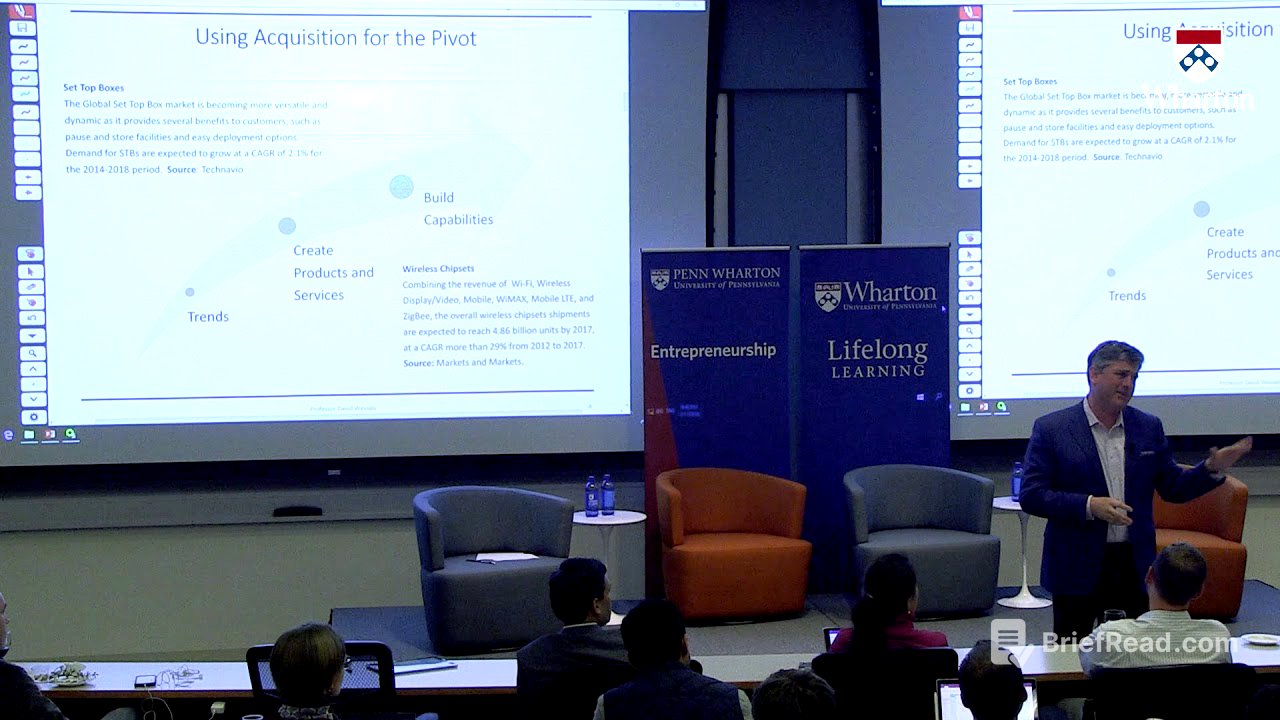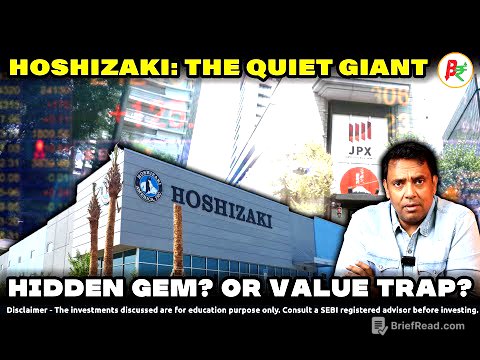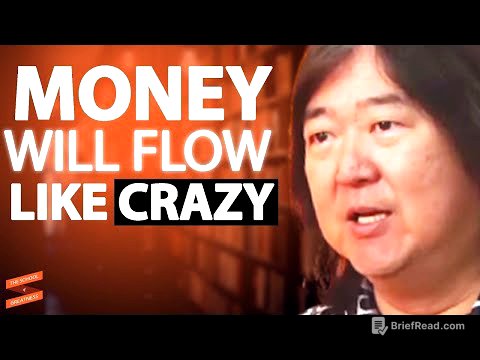TLDR;
This Wharton School event, the seventh of its kind, focuses on scaling ventures through mergers and acquisitions (M&A). The discussion, led by Professor Dave Wessels, covers the strategic importance of M&A in driving revenue growth, ensuring a healthy return on capital, and building sustainable organizations. The panelists share their experiences and insights on corporate development, M&A strategies, and integration processes.
- M&A is a tool for growth, not just a financial transaction.
- Strategy should drive M&A, not the other way around.
- Cultural fit is crucial for successful integration.
Introduction to Wharton Scale School [0:04]
Karl Ulrich, the Vice Dean of Entrepreneurship and Innovation at the Wharton School, kicks off the seventh Wharton Scale School event. He highlights Wharton's unique position in applying analytics, finance, marketing, and operations to help companies scale after achieving product-market fit. The school aims to share expertise in scaling new ventures, covering topics like scaling sales, using analytics, scaling talent, and connecting strategy with execution. This particular event focuses on scaling through acquisition.
The Role of Mergers and Acquisitions in Corporate Strategy [3:52]
Professor Dave Wessels discusses the role of mergers and acquisitions in making a company successful. He emphasizes the link between corporate strategy and value creation, highlighting three key drivers: revenue growth, a healthy return on capital, and long-term sustainability. Wessels introduces a McKinsey study called "the granularity of growth", which identifies portfolio momentum, capturing share and M&A as the three pistons of growth. Companies that excel in all three areas achieve best-in-class stock price performance.
Momentum Markets and Pivoting Towards Growth [10:19]
Wessels uses the example of a chipset company in the set-top box and wireless markets to illustrate the importance of pivoting towards momentum. He explains that companies need to identify the skills and capabilities required to succeed in new markets and decide whether to build them internally or acquire them. He emphasizes the importance of understanding customer trends and adapting to changing market dynamics.
Tactical View of M&A and Value Creation [18:33]
Wessels shifts to a more tactical view of M&A, focusing on how it can be used to grow the business and create value. He borrows from marketing literature, thinking about M&A in terms of customer lifetime value. He discusses how M&A can help companies develop new products and services for existing customers, improve product quality and satisfaction, increase customer retention, and acquire new customers. He also touches on the make-versus-buy decision, weighing the benefits of internal development against the speed and certainty of acquisition.
Pricing and Valuation Considerations [26:37]
Wessels addresses the challenges of pricing and valuation in M&A, noting that many deals fail to create value due to excessive premiums. He criticizes the reliance on comps tables, which often lack a connection to the real operating metrics of the business. He recommends tying valuation metrics back to operational statistics and having a robust team that can assess the real operational impact of an acquisition. He also notes that private companies may be more willing to accept lower prices in exchange for liquidity.
Panel Introduction and Corporate Development Roles [32:46]
Professor Wessels introduces the panel: Vicente de Baca, Anton Hain Brink, and Jaimie Kim. The panelists discuss their backgrounds and current roles in corporate development. Vicente de Baca describes his role at BT Ventures, which involves buying companies and helping with portfolio strategy. Anton Hain Brink discusses his role at Intuit, which encompasses M&A, divestitures, and minority investments. Jaimie Kim talks about her role at a growth-stage startup, focusing on capital raises and building relationships with strategic entities.
Strategic Alignment and M&A as a Tool [40:23]
The panelists discuss how M&A fits within their companies' overall strategies. Vicente de Baca emphasizes the importance of moving into attractive areas with high ROI and divesting from unattractive areas. Anton Hain Brink explains that M&A is highly valued at Intuit, with a significant portion of revenues coming from acquisitions. Jaimie Kim notes that her company is considering M&A as a way to knock out a competitor and gain market share.
Identifying and Screening Companies for Acquisition [44:11]
The panel discusses the process of identifying and screening companies for acquisition. Vicente de Baca explains that it involves creating a list of companies in the space, segmenting them by different characteristics, and talking to companies to gauge their interest in selling. Anton Hain Brink emphasizes the importance of internal knowledge and proactive outreach, rather than relying on bankers. He also stresses the need for a tournament approach, starting with a large set of companies and narrowing it down based on structured evaluation criteria.
Fit and Cultural Considerations in M&A [51:13]
The panelists discuss the importance of fit in M&A, including technical fit, cultural fit, and geographic fit. Anton Hain Brink notes that cultural fit matters more than one might think, as acquisitions can go sideways if the team doesn't gel. Vicente de Baca emphasizes the importance of cross-selling opportunities and synergies. Jaimie Kim highlights the value of knowledge sharing and cost structure synergies in roll-up acquisitions.
Negotiation and Valuation Strategies [54:10]
The panel explores negotiation and valuation strategies. Vicente de Baca admits that many companies don't approach valuation rigorously enough. Anton Hain Brink stresses the importance of starting discussions with potential targets in a cagey manner, without signaling too much interest in acquisition. He also highlights the value of developing relationships over a long period of time. Jaimie Kim notes that corporate venture arms are often used to build relationships and gain insights into potential acquisition targets.
Integration Process and Best Practices [1:01:10]
The panelists discuss the integration process, emphasizing that it is as challenging as getting the deal done. Vicente de Baca stresses the importance of starting integration planning as early as possible and avoiding a cookie-cutter approach. Anton Hain Brink notes that integration should start even before the LOI is signed, with a strawman integration approach developed. He also emphasizes the importance of having a designated integration lead who is involved early in the process and accountable for post-close metrics.
Disclosure Concerns and Integration Costs [1:09:28]
The panel addresses questions from the audience, including how to balance disclosure concerns with the need for integration planning. Anton Hain Brink recommends taking a constrained approach to disclosure, with a small core team involved initially. The panelists also discuss how to factor integration costs into the deal model and ensure that the GM commits to hitting the numbers.
Cycle Time and Competitive Markets [1:12:32]
The panelists discuss the cycle time of a transaction and how it can affect the business case. Anton Hain Brink shares Intuit's metrics for initial outreach to LOI (30 days or less) and LOI to close (60 days or less). They also address how to identify and value targets in competitive markets, such as AI, emphasizing the importance of specific skillsets and operationalizing the technology.
Evaluating Acquisitions and Key Learnings [1:18:26]
The panel discusses the evaluation of acquisitions, emphasizing the importance of setting criteria beforehand and prioritizing them according to the acquisition's goals. They also share key learnings about M&A from their careers. Audience members highlight the importance of building knowledge and experience with acquisitions over time, adding flexibility to benchmarks, and thoroughly vetting company culture.
Final Thoughts and Appreciation [1:25:26]
Professor Wessels thanks the panelists and the audience for their participation. He encourages attendees to spread the word about Wharton's presence in Silicon Valley. The event concludes with a final round of applause.









